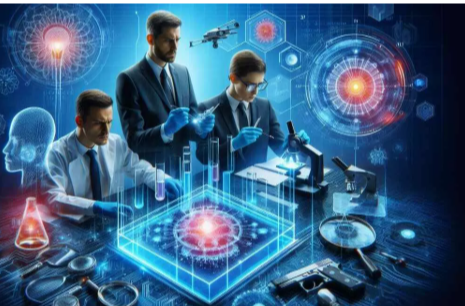The integration of technology into forensic science has significantly transformed investigative methods. Enhanced DNA analysis, advanced imaging techniques, and digital forensics have improved evidence collection and analysis. Furthermore, artificial intelligence plays an increasingly vital role in streamlining processes and enhancing data interpretation. As these innovations continue to evolve, they raise important questions about their implications for justice and the adaptability of law enforcement to new criminal behaviors. What challenges and opportunities lie ahead in this rapidly advancing field?
The Evolution of Forensic Technology
As advancements in science and technology have accelerated, the field of forensic science has undergone significant transformations, enhancing its ability to solve crimes and administer justice.
Forensic imaging techniques have evolved, allowing for clearer visualization of evidence. Additionally, automated analysis systems streamline data processing, increasing efficiency and accuracy in investigations.
These developments have fundamentally reshaped how forensic evidence is interpreted and utilized in legal contexts.
Advances in DNA Analysis
Forensic science has witnessed remarkable progress in DNA analysis, a key area that has revolutionized criminal investigations.
Advances in genetic sequencing techniques have enhanced the accuracy of forensic databases, enabling law enforcement to match DNA samples with unprecedented precision.
These innovations not only facilitate the identification of suspects but also play a crucial role in exonerating the innocent, thereby promoting justice and transparency.
Digital Forensics: Uncovering Cyber Crimes
An increasing number of criminal activities are now occurring in the digital realm, necessitating the field of digital forensics to adapt and evolve.
Digital forensics plays a crucial role in uncovering cyber crimes by analyzing digital evidence collected from various devices.
Effective cybersecurity measures are essential to protect sensitive information, while forensic experts strive to identify perpetrators and ensure justice in the virtual landscape.
The Role of Artificial Intelligence in Investigations
While traditional investigative techniques have proven effective in many cases, the integration of artificial intelligence (AI) into forensic investigations represents a transformative shift in how evidence is analyzed and interpreted.
AI algorithms facilitate predictive analytics and enhance crime pattern recognition, allowing investigators to identify connections and trends more efficiently.
Moreover, AI improves evidence classification, streamlining the investigative process and increasing the accuracy of conclusions drawn from complex data sets.
Conclusion
In a world where criminals can hardly keep up with their own digital footprints, forensic technology emerges as the relentless detective, wielding DNA swabs and algorithms like a superhero’s toolkit. As AI sifts through mountains of data and forensic imaging reveals hidden truths, one might wonder if the next step is for crime scenes to come equipped with a “Forensic Assistance Required” button. While justice becomes more efficient, the criminals must surely be reconsidering their career choices in this high-tech age.The integration of technology into forensic science has significantly transformed investigative methods. Enhanced DNA analysis, advanced imaging techniques, and digital forensics have improved evidence collection and analysis. Furthermore, artificial intelligence plays an increasingly vital role in streamlining processes and enhancing data interpretation. As these innovations continue to evolve, they raise important questions about their implications for justice and the adaptability of law enforcement to new criminal behaviors. What challenges and opportunities lie ahead in this rapidly advancing field?
The Evolution of Forensic Technology
As advancements in science and technology have accelerated, the field of forensic science has undergone significant transformations, enhancing its ability to solve crimes and administer justice.
Forensic imaging techniques have evolved, allowing for clearer visualization of evidence. Additionally, automated analysis systems streamline data processing, increasing efficiency and accuracy in investigations.
These developments have fundamentally reshaped how forensic evidence is interpreted and utilized in legal contexts.
Advances in DNA Analysis
Forensic science has witnessed remarkable progress in DNA analysis, a key area that has revolutionized criminal investigations.
Advances in genetic sequencing techniques have enhanced the accuracy of forensic databases, enabling law enforcement to match DNA samples with unprecedented precision.
These innovations not only facilitate the identification of suspects but also play a crucial role in exonerating the innocent, thereby promoting justice and transparency.
Digital Forensics: Uncovering Cyber Crimes
An increasing number of criminal activities are now occurring in the digital realm, necessitating the field of digital forensics to adapt and evolve.
Digital forensics plays a crucial role in uncovering cyber crimes by analyzing digital evidence collected from various devices.
Effective cybersecurity measures are essential to protect sensitive information, while forensic experts strive to identify perpetrators and ensure justice in the virtual landscape.
The Role of Artificial Intelligence in Investigations
While traditional investigative techniques have proven effective in many cases, the integration of artificial intelligence (AI) into forensic investigations represents a transformative shift in how evidence is analyzed and interpreted.
AI algorithms facilitate predictive analytics and enhance crime pattern recognition, allowing investigators to identify connections and trends more efficiently.
Moreover, AI improves evidence classification, streamlining the investigative process and increasing the accuracy of conclusions drawn from complex data sets.
Conclusion
In a world where criminals can hardly keep up with their own digital footprints, forensic technology emerges as the relentless detective, wielding DNA swabs and algorithms like a superhero’s toolkit. As AI sifts through mountains of data and forensic imaging reveals hidden truths, one might wonder if the next step is for crime scenes to come equipped with a “Forensic Assistance Required” button. While justice becomes more efficient, the criminals must surely be reconsidering their career choices in this high-tech age.




 The Challenges and Opportunities of Digital Currency Regulation
The Challenges and Opportunities of Digital Currency Regulation